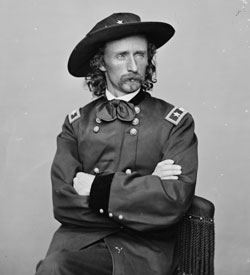One of America’s Most Controversial Leaders
January 16, 2012 Leave a Comment
 When the name Custer is mentioned it’s normally in the context of Little Big Horn. Most of us know – through documentaries, popular movies or middle school history – the story of Gen. George Armstrong Custer’s ill-fated battle on the West’s windswept plains. The battle pitted two larger-than-life antagonists against one another: Sitting Bull, the charismatic and politically savvy leader of the Plains Indians, and Custer, one of the Union’s greatest cavalry officers and a man with a reputation for fearless and often reckless courage. By day’s end, Custer and nearly a third of his army were dead.
When the name Custer is mentioned it’s normally in the context of Little Big Horn. Most of us know – through documentaries, popular movies or middle school history – the story of Gen. George Armstrong Custer’s ill-fated battle on the West’s windswept plains. The battle pitted two larger-than-life antagonists against one another: Sitting Bull, the charismatic and politically savvy leader of the Plains Indians, and Custer, one of the Union’s greatest cavalry officers and a man with a reputation for fearless and often reckless courage. By day’s end, Custer and nearly a third of his army were dead.
It’s rather unusual that the majority of us know Custer only for his final battle because the rest of his military career was nearly as fascinating, beginning with his famous charge at Gettysburg, which helped turn the war in the Union’s favor. Custer’s controversial career may have been filled with triumphs and disasters, but despite the disasters, Custer’s legacy was saved in large part by his wife Libbie, who worked almost single-handedly to mythologize his role in the Battle of the Little Big Horn as that of heroic sacrifice.
From Gettysburg to Little Big Horn, discover more about the controversial figure in Custer’s Last Stand: American Experience 7 p.m. Tuesday, Jan. 17. And prime yourself for this biopic by viewing a photo timeline of Custer’s milestones, beginning with his days at West Point.
Wisconsin Public Television Program History Documentary civil war PBS Wisconsin Public Television
 Passport
Passport





